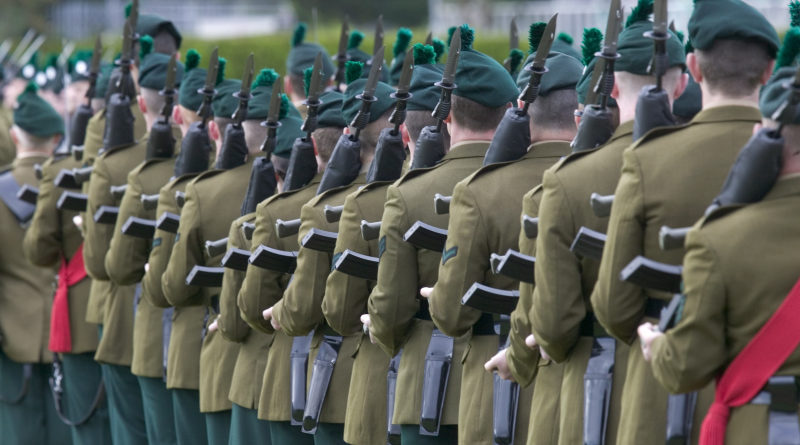
The Royal Irish Regiment (27th (Inniskilling), 83rd, 87th and Ulster Defence Regiment) is one of the most distinguished infantry regiments of the British Army, with a history that traces back over three centuries. Known for its bravery, resilience, and strong ties to the island of Ireland, the regiment has served with distinction in numerous conflicts around the globe.
Historical Background
The Royal Irish Regiment was formed on 1 July 1992 through the amalgamation of the Royal Irish Rangers (27th (Inniskilling), 83rd and 87th) and the Ulster Defence Regiment. The history of the regiment’s antecedent units stretches back to the late 17th century.
- 27th (Inniskilling) Regiment of Foot: Raised in 1689 during the Williamite War in Ireland, the regiment participated in numerous battles, including the Siege of Enniskillen.
- 83rd (County of Dublin) Regiment of Foot and 87th (Royal Irish Fusiliers) Regiment of Foot: Formed during the 18th century, these regiments served in the Napoleonic Wars, the Crimean War, and the Indian Mutiny.
- Royal Irish Rangers: Established in 1968 through the merger of the Royal Inniskilling Fusiliers, the Royal Ulster Rifles, and the Royal Irish Fusiliers.
- Ulster Defence Regiment: Created in 1970, the UDR was tasked with providing security in Northern Ireland during the Troubles.
Structure and Organization
The Royal Irish Regiment comprises both regular and reserve battalions, ensuring a versatile and capable force.
- 1st Battalion, The Royal Irish Regiment: A regular infantry battalion, trained for rapid deployment and conventional warfare.
- 2nd Battalion, The Royal Irish Regiment: Originally a general service battalion, this unit was merged with the 1st Battalion in 2007.
- Royal Irish Reserve: Composed of part-time soldiers, the reserve battalion supports the regular units, providing additional manpower and expertise.
Operational Role
The Royal Irish Regiment’s primary mission is to deliver infantry capabilities across a range of military operations. Their roles include:
- Infantry Operations: Engaging in direct combat, securing key positions, and providing security in various environments.
- Peacekeeping: Participating in international peacekeeping missions, contributing to stability and security in conflict zones.
- Counter-Terrorism and Security: Providing security and counter-terrorism support, particularly in Northern Ireland.
- Humanitarian Assistance: Delivering aid and support during natural disasters and humanitarian crises.
- Training and Advisory: Assisting in the training and development of foreign military forces.
Notable Deployments
The Royal Irish Regiment has been actively involved in numerous significant deployments:
- Northern Ireland: The regiment played a crucial role during the Troubles, providing security and support to civil authorities.
- Iraq: The Royal Irish Regiment was deployed to Iraq during Operation Telic, participating in combat and stabilization operations.
- Afghanistan: The regiment served in Afghanistan as part of Operation Herrick, contributing to counter-insurgency efforts and training Afghan security forces.
- Balkans: Participated in peacekeeping operations in Bosnia and Kosovo, helping to maintain stability in the region.
- Sierra Leone: The regiment was involved in operations to restore peace and security during the Sierra Leone Civil War.
Traditions and Culture
The Royal Irish Regiment maintains a rich array of traditions that reflect its deep historical roots and cultural heritage.
- Motto: “Faugh A Ballagh” (Clear the Way), a traditional Irish battle cry, embodies the regiment’s fighting spirit.
- Cap Badge: The regiment’s cap badge features the Irish harp, symbolizing its connection to Ireland.
- Regimental Marches: The regiment’s quick march is “Garryowen,” and its slow march is “The Meeting of the Waters,” both reflecting its Irish heritage.
- St. Patrick’s Day: Celebrated as the regiment’s official day, with soldiers traditionally wearing a sprig of shamrock.
- Regimental Mascot: The Irish wolfhound, a symbol of strength and loyalty, serves as the regiment’s mascot.
Modern Role and Adaptability
The Royal Irish Regiment continues to evolve to meet the challenges of contemporary military operations. The regiment’s adaptability ensures it remains capable of responding to a wide range of scenarios, from high-intensity conflict to peacekeeping and humanitarian missions. Continuous investment in training, equipment, and personnel development keeps the regiment at the forefront of the British Army’s operational capabilities.
Conclusion
The Royal Irish Regiment stands as a testament to the enduring legacy of Irish soldiers in the British Army. With a history marked by bravery, resilience, and a strong sense of identity, the regiment continues to serve with distinction in various operational theatres. Upholding its motto, “Faugh A Ballagh,” the Royal Irish Regiment embodies the fighting spirit and dedication that have defined its soldiers for centuries.